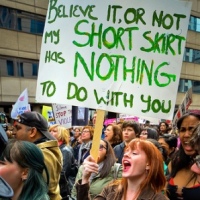Our socially dominating right-wing authoritarian Prime Minister, Tony Abbott, is talking more even more drivel than usual. ISIS, his pet death cult, are worse than the Nazis he claims, because unlike the Nazis, they have no shame.
I’ve searched far and wide. I can find no suggestion anywhere that the Nazis were ashamed of themselves. Never mind.
In practically the same breath Abbott has busied himself criminalising the estimated four million Syrian women, children and men fleeing their country and the ISIS death cult, by declaring them to be “illegal” immigrants.
In other words, death cult is badder than bad Nazis, but fleeing bad death cult is even badder then bad Nazis AND badder death cult?
Prime Minister Abbott then co-opted the death by drowning of Syrian toddler Aylan Kurdi to justify his stop the boats campaign, saying at least we don’t have drowned babies washing up here anymore because we’ve stopped the boats.
By the way, remember the Christmas Island boat tragedy when then immigration spokesperson Scott Morrison said we shouldn’t pay for the funerals of drowned babies? Flying corpses to the mainland for burial, Morrison said, was not giving taxpayers “value for money.”
(I urge you to read the article in New Matilda I’ve linked to in my first sentence, for an insight into the psychology of right-wing authoritarians. It explains much.)
British Murdoch columnist Katy Hopkins suggested that Europe should adopt Australia’s approach to asylum seekers by “threatening them with violence until they bugger off.” Which is a pretty good précis of off-shore detention, when you think about it. Australians have big balls and tiny hearts, Katy claims, admiringly, as apparently that’s the perfect combination for male-dominated leadership and murdering, directly and indirectly, millions of people seeking asylum.
At this point things become confusing. Nazis are bad for murdering millions but they have the capacity for shame, so not as bad as ISIS death cult who aspire to murder millions, as many as possible on social media so definitely no shame, so badder than Nazis. But Europeans should directly and indirectly murder millions and that’s good, no shame required, because big balls and tiny hearts are great. As long as they’re in white, non-Nazi bodies. Right.
Meanwhile, the New York Times published an excoriating editorial damning Abbott’s ruthless and inhumane asylum seeker policies. For which Abbott feels no shame, because…all right, I won’t say it all again but if he gets to talk in threes why can’t I?
There was considerable robust debate the other day concerning whether or not the image of the tiny body of Aylan Kurdi, washed up drowned on the beach, should have been published by The Guardian, and re-posted on social media.
For mine, the very fact of this debate highlighted our privilege: we do not have to directly deal with such horrendous circumstances, rather, from a safe distance, we have the option to debate whether or not it is kind or unkind to us that we are confronted with images of those circumstances.
There seems to be an attitude about that we have an inherent right not to be disturbed and discomfited. We don’t. Nobody was forced to look at the images, and warnings were issued for those who wanted to turn away. As Carol Duncan quite rightly tweeted, if you don’t want to see the pictures, exercise your privilege and turn off your devices.
With millions of displaced, desperate people roaming the globe, and the numbers set to increase, we have no right to demand censorship of images of their plight. If you don’t want to see it, don’t look, but please, spare us the preciousness of your complaints that you are traumatised by looking.
Shame, anyone?









































Recent Comments